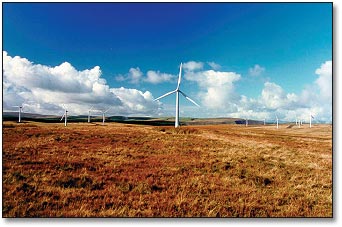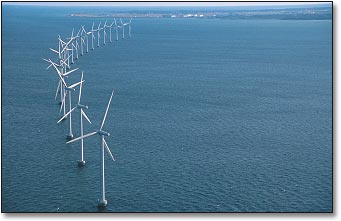Exercise 1.Complete the sentences with the suggested words: away, about, by, into, times
The sun radiates huge quantities of energy ______the surrounding space, and the tiny fraction intercepted ______the Earth's atmosphere, 150 million km_____, is nonetheless equivalent to ______15,000 ______humanity's present rate of use of fossil and nuclear fuels.
Exercise 2. Fill in the table with words and expressions from the text:
| chemical elements | devices | materials | |
| Example: Nuclear fusion reactions convert | hydrogen into heavier elements. | ||
| Photovoltaic modules are made of | |||
| Solar power can be harnessed by | |||
| Heating can be done by |
Exercise 3. Compose a story on one of the topics (up to 100 words):
“Human Life and the Sun”
“Harnessing the Solar Energy”
LESSON 3
THE READING MODULE
Read the text: INDIRECT USE OF SOLAR ENERGY
The above examples illustrate the direct harnessing of the sun's radiant energy to produce heat and electricity. But the sun's energy can also be harnessed via other forms of energy that are indirect manifestations of its power. Principally, these are bioenergy and hydropower, already discussed above, together with wind energy and wave power.
Wind energy
When solar radiation enters the earth's atmosphere, because of the curvature of the earth it warms different regions of the atmosphere to differing extents – most at the equator and least at the poles. Since air tends to flow from warmer to cooler regions, this causes what we call winds, and it is these air flows that are harnessed in windmills and wind turbines to produce power.
Wind power, in the form of traditional windmills used for grinding corn or pumping water, has been in use for centuries. But in the second half of the twentieth century, and particularly in the past few decades, the use of modern wind turbines for electricity generation has been growing very rapidly. Installed wind generating capacity has doubled every two and a half years since 1991, and at the end of 2001 the world total was over 23,000 MW. (Windpower Monthly, 2002) Denmark derives more than 15% of its electricity from wind, and in other countries such as Germany, Spain and the United States of America turbines have in recent years been installed at a rate of more than a thousand megawatts per year.
 |
Figure: This wind farm, at Carno in mid-Wales, is one of the largest in Europe. It incorporates 56 wind turbines, each with a rotor diameter of 44 metres and a tower height of 31.5 metres. The total installed capacity is 33.6 MW, sufficient to provide power for some 25,000 homes
At present, most of these turbines have been installed on land. But several countries have ambitious plans to install thousands of wind turbines offshore. Denmark, for example, has three offshore wind farms and plans many more, as part of its aim of deriving 30 per cent of its electricity from wind by 2020 – though these plans are subject to future political approval.

Figure: The Middelgrunden wind farm, completed in 2001, is located in the sea just off Copenhagen harbour in Denmark. It includes 20 two megawatt wind turbines, which provide 3 per cent of the electricity consumption of the Copenhagen municipality
The UK, too, has ambitious offshore wind power proposals. Britain's first two offshore wind turbines were installed off Blyth harbour in Northumberland in 2000, and sites have been identified for 13 offshore wind farms that could be built in the coming decade. These would have a total installed capacity of 1600 MW.

Figure: Britain's first offshore wind turbines, located 1 km away from the coast at Blyth harbour, Northumberland. The twin 2 MW turbines were installed in 2000 by a consortium including AMEC, Border Wind, Shell Renewables and the Dutch electricity utility Nuon
(to be continued)
After text activity
I. Reading exercises:
Exercise 1.Read and memorize using a dictionary:
| harnessing of energy, wind energy, wave power, solar radiation, curvature, windmill, wind turbine, generating capacity, installed capacity, offshore wind farm, to derive electricity, electricity consumption, site, renewables, electricity utility |
Exercise 2.Answer the questions:
1) What are the indirect manifestations of sun’s power?
2) Where does the solar radiation warm the atmosphere most?
3) How long has wind power been in use?
4) Where are most of wind turbines installed at present?
Exercise 3.Match the left part with the right:
| 1. Indirect manifestations of sun’s power are | a) installed on land. |
| 2. Air-flows from cooler to warmer regions are | b)bioenergy, hydropower, wind energy and wave power |
| 3. Most of wind turbines have been | c) growing very rapidly. |
| 4. The use of wind turbines for electricity generation has been | d)harnessed by windmills and wind turbines to produce power. |
THE SPEAKING MODULE
II. Speaking exercises:
Exercise 1.Describe indirect harnessing of sun’s radiant energy; winds; wind power; wind turbine; installed generating capacity; electricity utilityusing the suggested words and expressionsas in example:
| indirect harnessing of sun’s radiant energy sun’s energy, via, wave power, bioenergy, hydropower, wind energy, principally example Indirect harnessing of sun’s radiant energy can be done via other forms of energy, principally, bioenergy and hydropower, wind energy and wave power |
| winds air, motion, earth’s surface, relative, cooler, warmer regions, from. |
| wind power derived, from, motion, windmill, wind turbine, energy, through |
| wind turbine to convert, electrical energy, into, windmill, advanced type |
| installed generating capacity maximum, runoff, electric facility, by, constantly, maintained, utilized, equipment. |
| electricity utility facility, generation, electric power, processing |
Exercise 2.Ask questions to the given answers:
1) Question: ____________________________________________________?
Answer: At the end of 2001 the world total installed wind generating capacity was over 23,000 MW.
2) Question:_____________________________________________________?
Answer: The wind farm at Carno in mid-Wales is one of the largest in Europe.
3) Question:_____________________________________________________?
Answer: Denmark derives more than15% of its electricity from wind.
THE WRITING MODULE
III. Writing exercises:
Exercise 1.Complete the sentences with the suggested words: